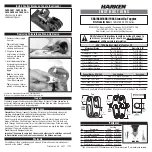
USER SAFETY INFORMATION
x
Wireless Data Transmission
Some Mortara electrocardiographs can be equipped with an optional wireless data transmission module
(WLAN or GSM/GPRS mobile). Both these technologies use radios to transmit data to a Mortara receiving
application. Due to the nature of radio transmissions, it’s possible that, due to the characteristics of the
environment where the device is located, some other RF sources may interfere with the transmission generated
by the device. Mortara Instrument has tested the coexistence of the device with other devices that can interfere
such as devices using WLAN, Bluetooth radio, and/or cell phones. Although the current technology allows a
very successful rate of transmission, it’s possible that in some rare occurrences, the system may not perform at
its best resulting in a “failed transmission”. When this occurs, patient data will not be erased from the device
nor stored in the receiving application, ensuring that partial or corrupted data are not made available to the
receiving station. If the failure mode persists the user should move to a position where the RF signals may
propagate better and allow successful transmissions.
WLAN Option
Wireless options transmit at 2.4 GHz. Other nearby wireless devices may cause interference. If possible, move
or turn off other devices to minimize potential interference.
The following table shows the channels allocated in different geographic areas in the world. Please
consult
with your IT personnel in order to set the device on the proper channels.
Specification
Description
Technology
IEEE 802.11 b/g DSSS, WiFi compliant
Frequency
2.400 – 2.4835 GHz (U.S./CAN/Japan/Europe)
2.471 – 2.497 GHz (Japan)
Channels
U.S.A./CANADA: 11 channels (1-11)
Europe: 13 Channels (1-13)
Japan: 14 Channels (1-14)
France: 4 Channels (10-13)
RF Power
+15dBm (typical) approx. 32 mW
Summary of Contents for ELI 10 Rx
Page 14: ...USER SAFETY INFORMATION xii...
Page 18: ...GENERAL CARE xvi...
Page 42: ...SECTION 3 18...
Page 68: ...APPENDIX B 44...













































